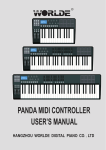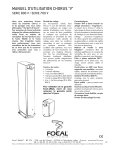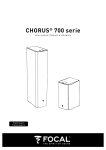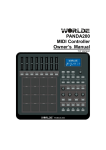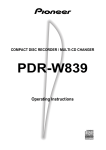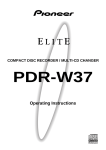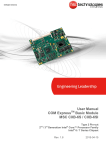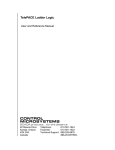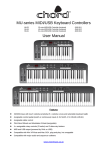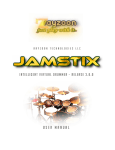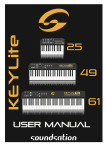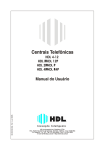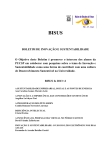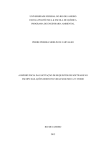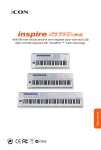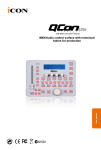Download User Manual / Manual do Usuário
Transcript
USB/MIDI Keyboard Controller with Rotary Encoders and Trigger Pads User Manual / Manual do Usuário Important Safe Instructions 1. Read these instructions before operating this apparatus. 2. Keep these instructions for future reference. 3. Heed all warnings to ensure safe operation. 4. Follow all instructions provided in this document. Caution Risk of Electric Shock Do Not Open To reduce the risk of electric shock, do not remove cover (or back). No user serviceable parts inside. Refer servicing to qualified personnel. 5. Do not use this apparatus near water or in locations where condensation may occur. 6. Clean only with dry cloth. Do not use aerosol or liquid cleaners. Unplug this apparatus before cleaning. 7. Do not block any of the ventilation openings. Install in accordance with the manufacturer’s instructions. 8. Do not install near any heat sources such as radiators, heat registers, stoves, or other apparatus (including amplifiers) that produce heat. 9. Do not defeat the safety purpose of the polarized or grounding-type plug. A polarized plug has two blades with one wider than the other. A grounding type plug has two blades and a third grounding prong. The wide blade or the third prong is provided for your safety. If the provided plug does not fit into your outlet, consult an electrician for replacement of the obsolete outlet. 10. Protect the power cord from being walked on or pinched particularly at plug, convenience receptacles, and the point where they exit from the apparatus. 11. Only use attachments/accessories by the manufacturer. 12. Unplug this apparatus during lighting storms or when unused for long periods of time. 13. Refer all servicing qualified to service personnel. Servicing is required when the apparatus has been damaged in any way, such as power-supply cord or plug is damaged, liquid has been spilled or objects have fallen into the apparatus, the apparatus has been exposed to rain or moisture, does not operate normally, or has been dropped. 14. Before installation, ensure that the voltage and frequency of power outlet match the power requirements of the loudspeaker. 15. Disconnect from main power before to make connections in the loudspeaker. 16. Make sure that the power-cord is never crimped or damaged by sharp edges. Never let the power-cord come into contact with other cables. Only handle the power-cord by the plug. 17. In case to replace the fuse, it must be changed by identical rate and dimensions. This symbol on the product or on its packaging indicates that this product shall not be treated as household waste. Instead it shall be handed over to the applicable collection point for the recycling of electrical equipment. By ensuring this product is disposed of correctly, you will help prevent potential negative consequences for the environment and human health, which could otherwise be caused by inappropriate waste handling of this product. The recycling of materials will help to conserve natural resources. For more detailed information about recycling of this product, please contact your local city office, your household waste disposal service or the shop where you purchased the product. Instruções de Segurança 1. Leia estas instruções antes de operar a unidade. 2. Mantenha estas instruções para referência futura. 3. Siga todos os avisos para assegurar a operação em segurança. 4. Siga as instruções contidas neste documento. Caution Risco de Choque Elétrico Não Abra Para reduzir o risco de choque elétrico ou fogo, não exponha este aparelho à chuva ou umidade. 5. Não utilize este aparelho próximo à água ou em locais onde ocorra condensação. 6. Limpe usando apenas um pano seco e macio. Não utilize limpadores em aerosol ou líquidos. Retire o aparelho da tomada antes de efetuar a limpeza. 7. Não obstrua as aberturas de ventilação. Instale de acordo com o recomendado pelo fabricante. 8. Não instale o aparelho perto de fontes de calor, tal como radiadores, fogões, amplificadores e outros aparelhos que produzam calor. 9. Não inutilize o dispositivo de segurança dos cabos polarizados e do cabo de três pinos. O cabo polarizado possui duas lâminas sendo uma, mais grossa que a outra. O cabo de três pinos possui o pino central para segurança. Se o conector proporcionado não entra em sua tomada, consulte um eletricista para o uso de adaptadores ou a troca da tomada. 10. Proteja o cabo de força de ser pisado ou pinçado, principalmente no conector e no ponto onde o cabo sai do aparelho. Este símbolo impresso no produto ou em sua embalagem indica que este produto não deve ser tratado como lixo doméstico. Ao invés disso, deve ser encaminhado para centros de coleta / reciclagem de materiais eletrônicos. Ao garantir que este produto seja coletado da maneira correta, você irá ajudar a prevenir conseqüências negativas para o meio ambiente e para a saúde humana. A reciclagem pode ajudar na preservação de diversos recursos naturais. Para mais informações sobre centros de coleta e reciclagem de produtos eletrônicos, por favor, acesse o site: www.lixoeletronico.org O uso de controles, ajustes ou a execução de procedimentos que não sejam os especificados neste manual podem resultar em danos físicos e exposição à radiação que pode ser prejudicial à saúde. 11. Use apenas acessórios especificados pelo fabricante. 12. Desconecte o aparelho da tomada durante tempestades elétricas ou quando não for usá-lo por longos períodos. 13. Sempre encaminhe seu aparelho a uma assistência técnica autorizada. O conserto é necessário sempre que o aparelho tenha sido danificado de qualquer forma, tal como problemas na fonte de alimentação, cabo de força, infiltração de líquidos ou objetos, exposição do aparelho a chuva ou umidade ou caso tenha sido sofrido alguma queda. 14. Antes de instalar o produto, garanta que a voltagem selecionada é igual a voltagem da tomada na qual o produto será plugado. 15. Desligue o aparelho e desconecte o cabo de força antes de conectar qualquer outro equipamento / acessório em suas entradas. 16. Assegure-se de que o cabo de energia não está danificado ou descascado. Nunca utilize o equipamento caso o cabo de energia esteja descascado ou com a fiação interna aparente. Nunca desconecte o equipamento da tomada puxando-o pelo cabo de energia. Sempre conecte e desconecte o equipamento encaixando / desencaixando cuidadosamente o conector na tomada. 17. Caso seja necessária a substituição do fusível, garanta que um técnico realize a troca, utilizando para isso um fusível das mesmas dimensões e capacidade elétrica. O símbolo do raio dentro de um triângulo representa o risco de voltagem perigosa, não isolada, que pode ter magnitude suficiente para produzir um choque elétrico severo. O ponto de exclamação dentro de um triângulo alerta o usuário quanto a presença de informações importantes sobre operação na literatura que acompanha o aparelho. Introduction / Introdução The eight fully assignable pads give you the ability to trigger samples. The eight fully assignable endless rotary encoders and sliders can be assigned as135 controllers. The versatile and easy-to-use Carbon keyboard is a great controller in the studio and live on stage. Os 8 pads totalmente endereçáveis proporcionam o disparo de samples. Os 8 encoders (codificadores) contínuos totalmente endereçáveis e os sliders (deslizantes) podem ser endereçados como controladores 135. O versátil teclado Carbon é fácil de usar e é um grande controlador de estúdio e ao vivo, no palco. Functions / Funções • 8 trigger pads with velocity • 2xAssinable Pedal Interfaces (PEDAL A,PEDAL B), which can be assigned as 135 controllers • 8xAssignable Dials. Each dial can establish an independent channel , and can be assigned as 135 controllers • 8xAssignable Slider, each slider can be assigned as 135 controllers • Assignable Pitch Bend Wheel and Modulation Wheel(Wheel P & Wheel M),which can be assigned as 135 controllers • 6 Buttons for MMC. • 1xMaster Volume Slider. • 8 double Function button with shift, providing 15 functions like PROGRAM, CHANNEL, VEL-CURVE, OCTAVE, TRANSPOSE, BANK M, BANK L, DUAL, SPLIT, MUTE, AFTER TOUCH, CONTROL ASSIGN and etc. • 10xData entry and +/- button. • Built-in Memory, which can store/load 6 groups of user’s parameter. • 1xMIDI OUT,1X MIDI IN • USB interface, adaptable to USB 2.0(FULL SPEED). Power supplied by USB and DC 9 V. • Have the ability for future upgrading via USB • Compatible with Windows XP/Vista/Windows7 and Mac OSX. • Drive free and hot-plug supported. • 8 pads disparadores com velocidade; • 2 interfaces de pedal endereçáveis (Pedal A, Pedal B) que podem ser endereçadas como controladores 135; • 8 dials endereçáveis. Cada dial pode ser ajustado como canal independente e pode ser endereçado como controlador 135; • 8 deslizantes (slider) endereçáveis, que podem ser endereçados como controladores 135; • Rodas Pitch Bend e Modulation (Wheel P e Wheel M), que podem ser endereçadas como controladores 135; • 6 botões para MMC; • 1 slider (deslizante) de Volume Master; • 8 botões de função dupla com shift (alternador), fornecendo 15 funções como PROGRAM, CHANNEL, VEL-CRUVE, OCTAVE, TRANSPOSE, BANK M, BANK L, DUAL, SPLIT, MUTE, AFTER TOUCH, CONTROL ASSIGN, etc.; • 10 entradas de dados e botão +/• Memória integrada que pode guardar/carregar 6 grupos de parâmetros de usuários; • 1 MIDI IN, 1 MIDI OUT; • Interface USB, adaptável a USB 2.0 (FULL SPEED – VELOCIDADE COMPLETA). Fonte de alimentação por USB e DC 9V; • Upgrade pode ser realizado através de USB; • Compatível com Windows XP/Vista/Windows7 e Mac OSX • Conta com driver grátis e suporte hot plug; Controls and Connections / Controles e Conexões 1: LCD DISPLAY 2: Slider (49/61 only) 3: Encoders 4: Transport buttons 5: Assignable buttons (49/61 only) 6: Trigger Pads 7: Function buttons 8: Numeric keypad 9: Pitch Bend wheel 10: Modulation wheel 11: Keyboard with Aftertouch 12: Pedal A 13: Pedal B 14: MIDI OUT port 15: MIDI IN port 16: USB 2.0 port 17: DC power socket 18: Power switch 1. Display LCD 2. Slider-deslizante (somente no 49/61) 3. Encoders 4. Botões de Transposição 5. Botão Endereçável (somente no 49/61) 6. Pads Dispadores 7. Botões de Função 8. Teclado Numérico 9. Roda Pitch Bend 10. Roda Modulation 11. Teclado com Aftertouch 12. Pedal A 13. Pedal B 14. Porta MIDI OUT 15. Porta MIDI IN 16. Porta USB 2.0 17. Soquete DC Power 18. Chave Power Setup / Ajustes If you intend to connect your Carbon keyboard to a computer, please read first the following instructions. If you only intend to use your Carbon keyboard to control a sound module or synthesizer using the external MIDI OUT you should skip to “MIDI Connections” Caso você pretenda conectar seu teclado Carbon em um computador, por favor, leia primeiramente as instruções abaixo. Caso pretenda usar seu teclado Carbon para controlar um módulo de som ou sintetizador, usando a saída externa MIDI OUT, consulte a seção “Conexões MIDI” Minimum System Requirements: If you are using your Carbon with a computer, the following minimum system requirements apply: Requisitos Mínimos de Sistema: Caso esteja usando o Carbon com um computador, aplicam-se os seguintes requisitos mínimos: Windows Windows Pentium 3 800 MHz or higher Pentium 3 800 MHz ou superior (CPU requirement may be higher for laptops) Requisito de CPU pode ser maior para laptops 256 MB RAM 256 MB RAM DirectX 9.0b or higher DirectX 9.0b ou mais recente Windows XP (SP2) or higher Windows XP (SP2) ou mais recente (Windows 98, Me, NT or 2000 not supported) Windows 98, Me, NT ou 2000 não são suportados. Mac OS Mac OS Macintosh G3* 800/G4* 733 MHz or higher Macintosh G3* 800/G4* 733 MHz ou mais recente (CPU requirement may be higher for laptops) Requisito de CPU pode ser maior para laptops OS X 10.3.9 with 256 MB RAM OS x 10.3.9 com 256 MB RAM OS X 10.4.2 or greater with 512 MB RAM OS x 10.4.2 ou mais recente com 512 MB RAM *G3/G4 accelerator cards are not supported. Cartões Aceleradores *G3/G4 não são suportados. Using Carbon with your software Usando Carbon com seu software If you have connected external MIDI gear like a drum machine or another keyboard to your Carbon’s MIDI IN port, this gear can be interfaced to the computer by selecting the listed Carbon input port. Se você conectou um equipamento externo MIDI como uma bateria eletrônica ou outro teclado na porta MIDI IN do Carbon, este equipamento pode ser interligado ao computador, através da seleção da porta de entrada do Carbon. This way, your Carbon is acting as a MIDI to USB interface. Desta forma, seu Carbon está atuando como uma interface MIDI para USB. The port names are defined as USB Audio Device when connecting to USB port. It will appear as a single USB Composite Device in the Device Manager. Os nomes das portas são definidos como USB Audio Device (Aparelho de Áudio USB) quando conectado a uma porta USB. Aparecerá como um simples Aparelho de Composição USB no gerenciador de aparelhos. MIDI Connections / Conexões MIDI The MIDI Out port accepts a standard 5-pin DINtype MIDI plug (available from most professional audio retailers). A porta MIDI Out aceita plug padrão 5 pinos DIN tipo MIDI (disponível na maioria das lojas de áudio profissional). The MIDI Out port can be used to connect Carbon to a hardware sequencer, an external synthesizer or sound module, for example. A porta MIDI Out pode ser usada para conectar o Carbon a um sequenciador de hardware, um sintetizador externo ou módulo de som, por exemplo. Power Supply / Fonte de Alimentação If you are using your Carbon with a computer via its USB port, there is no need for an external power supply. Your Carbon will draw its power from the computer. Se estiver usando seu Carbon com um computador através de sua porta USB, não haverá necessidade de fonte de alimentação externa. Seu Carbon irá extrair a energia do computador. However, if you are intending to use your Carbon without connecting to a computer’s USB port, then you will need to use an external power supply. No power supply is included in the box, so please select one that meets the following requirements: Contudo, se pretender usar seu Carbon sem conectar a uma porta USB de computador, então necessitará usar uma fonte de alimentação externa. Não há fonte de alimentação inclusa na embalagem. Então, por favor, selecione uma que tenha os seguintes requisitos: < 9 V DC < 250 mA – 300 mA < Center positive < 9 V DC < 250 mA – 300 mA < Positivo Central Basic MIDI Control From Your Carbon Controle MIDI Básico do seu Carbon Your Carbon controller will not make any sound unless it is connected to a computer or other external MIDI gear. This is because the Carbon sends MIDI data when you play it and does not produce sound on its own. Instead, it is used to control a virtual instrument on your computer or a MIDI sound module to generate sounds. Seu controlador Carbon não produz qualquer som, a não ser que esteja conectado a um computador ou outro aparelho externo MIDI. Isto porque o Carbon envia dados MIDI quando você toca e não produz som por si próprio. Como alternativa, é usado para controlar um instrumento virtual no seu computador ou um módulo de som MIDI para gerar som. This is a good place to introduce you to the way we approach the differences between the Carbon 61 and 49 and the Carbon 25. The appearance and functionality of the Carbon 61 and 49 are the same, it’s just the size of the keyboard that is different, so when we give instructions for these models, these two are always grouped together. The Carbon 25 looks different and a number of its functions are accessed in a different way, so for this model we will always give you a separate set of instructions. Esta é uma boa hora para lhe apresentar as diferenças entre o Carbon 61, 49 e 25. A aparência e funcionalidade do Carbon 61 e 49 são as mesmas – apenas o tamanho do teclado é diferente – por isso, quando apresentamos instruções para estes modelos, estarão sempre juntas. O Carbon 25 possui aparência diferente e algumas de suas funções são acessadas de forma diferente. Por este motivo, as instruções serão fornecidas separadamente. Function Keys / Chaves de Funções • Carbon 49 and 61 Functions / Funções do Carbon 49 e 61 Carbon 49/61 keys / Teclas do Carbon 49/61 • Carbon 25 Functions / Funções do Carbon 25 Carbon 25 keys / Teclas do Carbon 25 • Numeric Keypad / Teclado Numérico Use the numeric keypad to enter values during programming. The LCD display will show the values as you enter them. Use o teclado numérico para inserir valores durante a programação. O display LCD mostrará os valores assim que inseri-los The Keyboard / O Teclado When you play the keyboard, MIDI note messages are sent. These messages are read by your computer software or external MIDI gear and used to generate sound accordingly. Quando você toca o teclado, mensagens de nota MIDI são enviadas. Estas mensagens são lidas pelo software do seu computador ou equipamento MIDI externo e usadas para gerar som. • Velocity Curve / Curva de Velocidade Every time you press a key, a MIDI note message is sent with a velocity value between 0 and the maximum; this value specifies how hard you pressed the key. Since different people have different playing styles, your Carbon offers a number of different velocity curves. You should experiment with the different velocity curves to find the curve that best suits your playing style. Toda vez que pressiona uma tecla, uma mensagem de nota MIDI é enviada com um valor de velocidade entre 0 e o máximo; este valor especifica qual a pressão com a qual você pressionou a tecla. Uma vez que pessoas diferentes possuem estilos de tocar diferentes, seu Carbon oferece número diferente de curvas de velocidade. Você deve experimentar as diferentes curvas para encontrar aquela que melhor se adapta ao seu estilo de tocar. • To change the velocity curve / Para trocar a curva de velocidade CURVE Velocity Curve selection function button. When this button is valid, the LCD displays the ‘VelCURVE’ and the number of current velocity curve. It can be adjusted by +/- button or Numeric Button and confirmed by Enter button. The initial value is 1, adjusting scale is 1~6.The LCD displays the following: CURVE Botão de função de seleção de curva de velocidade. Quando este botão está válido, o LCD mostra “VelCURVE” e o número da atual curva de velocidade. Pode ser ajustada através do botão +/- ou Botão NUMERIC e confirmada pelo botão Enter. O valor inicial é 1 e a escala de ajuste é 1~6. O LCD mostra o seguinte: OCTAVE Octave adjusting function button. This function allows the keyboard to change the Pitch up/ down by octave. When this button is valid, the LCD shows the ‘OCTAVE’ and the value of current transposition. It can be adjusted by +/- button. The initial value is 0,adjusting scale is -4~5. The LCD displays the following: OCTAVE Botão de função de ajuste de oitava. Esta função permite que o teclado mude o Pitch up/down pela oitava. Quando este botão está válido, o LCD mostra “OCTAVE” e o valor da transposição atual. Isto pode ser ajustado pelo botão +/- . O valor inicial é 0 e a escala de ajuste é -4~5. O LCD mostra o seguinte: TRANSPOSE Transpose adjusting function allows the keyboard to change the Pitch up/down by semi-tone. When this button is valid, the LCD displays the ‘x’pose’ and the value of current transpose. It can be adjusted by +/-button. The initial value is 00, adjusting scale is -12~12. The LCD displays the following: TRANSPOSE Função de ajuste de transposição permite que o teclado mude o Pitch up/down pelo semitom. Quando este botão está válido, o LCD mostra “X POSE” e o valor da transposição atual. Isto pode ser ajustado pelo botão +/- . O valor inicial é 00 e a escala de ajuste é -12~12. O LCD mostra o seguinte: Channel / Channel Channel selection function button, selecting current MIDI channel. When this button is valid, the LCD displays the ‘Channel’ and the current channel number. The channel can be selected with +/- Button or Numeric button and confirmed by Enter button. The initial setting is 1,adjusting scale is 1~16.The LCD displays the following: Botão de função de seleção de canal, selecionando o canal MIDI atual. Quando este botão está acionado, o LCD mostra “CHANNEL” e o número do canal atual. O canal pode ser selecionado com o botão +/- ou botão NUMERIC e confirmado pelo botão Enter. O ajuste inicial é 1 e a escala de ajuste é -1~16. O LCD mostra o seguinte: Changing Voice and Voice Bank Mudando Voz e Banco de Voz PROGRAM Voice adjusting function button. adjusting the voice of current channel. When this button is valid, the LCD displays the ‘Program’ and the current voice number. The voice can be adjusted or selected with NUMERIC button or +/-Button. The initial setting is 00,adjusting scale is 0~127.The LCD displays the following: PROGRAM Botão de função de ajuste de voz, ajustando a voz do canal atual. Quando este botão está acionado, o LCD mostra “Program” e o número de voz atual. A voz pode ser ajustada ou selecionada com o botão NUMERIC ou +/-. O ajuste inicial é 00, escala de ajuste é 0~127. O LCD mostra o seguinte: BANK L/M Voice bank adjusting function button, adjusting the voice bank of current channel. When these buttons are valid, the LCD displays the ‘BANK L/M’ and the current voice bank number. The voice can be adjusted or selected with NUMERIC button or +/- Button. The initial setting is 00,adjusting scale is 0~127. BANK L/M Botão de função de ajuste de banco de voz, ajustando o banco de voz do canal atual. Quando estes botões estão acionados, o LCD mostra “BANK L/M” e o número do banco de voz atual. A voz pode ser ajustada ou selecionada com o botão NUMERIC ou +/-. O ajuste inicial é 00, escala de ajuste é 0-127. MIDI Controller Messages / Mensagens de Controlador MIDI There are 135 MIDI controller messages that are used for controlling the MIDI-adjustable parameters in your software or on your external MIDI gear. Examples of these controllable parameters include volume, pan, expression, reverb, chorus and portamento. Existem 135 mensagens de controlador MIDI que são usadas para controlar os parâmetros MIDI-ajustáveis no seu software ou no seu equipamento MIDI externo. Exemplos destes parâmetros controláveis incluem volume, pan, expression, reverb, chorus e portamento. Each of the controls on your Carbon keyboard is able to send any of the 128 standard MIDI controller messages to control such parameters. Please note that in order for these effects to work, the MIDI device you are sending to must be able to receive these messages. A full list of these control messages is given in Appendix C. Cada um dos controles no seu teclado Carbon está apto para enviar qualquer das 128 mensagens do controlador MIDI padrão para controlar tais parâmetros. Por favor, note que a fim de que estes efeitos funcionem, o aparelho MIDI ao qual você está enviando deve estar apto para receber estas mensagens. Uma lista completa destas mensagens de controle está no Apêndice C. For example, you may want to set the Modulation wheel to control the reverb amount. This is done by assigning controller 91 to the Modulation wheel. Por exemplo, você quer ajustar a roda Modulation para controlar o montante de reverb. Isto é feito através do endereçamento do controlador 91 à roda Modulation. Examples of other popular effects are listed in the table below. (Please consult Appendix C for the full list.) Exemplos de outros efeitos populares estão listados na tabela abaixo. Consulte o Apêndice C para a lista inteira. Effect / Efeito Control Number / Nº de Controle Modulation 1 Volume 7 Pan 10 Expression 11 Reverb depth 91 Chorus depth 93 There are many different types of virtual instruments available and most of these respond to MIDI controller messages, allowing you to control a variety of parameters from your Carbon keyboard. Please review the manual that came with your software or external gear to see what these controller numbers are. Existem vários tipos diferentes de instrumentos virtuais disponíveis e a maioria deles responde às mensagens do controlador MIDI, permitindo que você controle uma variedade de parâmetros do seu teclado Carbon. Por favor, reveja os manuais que vêm com seu software ou aparelho externo para verificar quais são estes números de controladores. • Programming the Controls / Programando os Controles When programming a physical controller on your Carbon, the controller that was last used will be the first one selected for programming. To select a different physical controller for programming,t.he method is: Move the physical controller you wish to program ,and press the assignable button. When in assign, the LCD displays the following: Quando programando um controlador físico no seu Carbon, o controlador que foi usado por último será o primeiro selecionado para programação. Para selecionar um controlador fisicamente diferente para programação, o método é: mova o controlador físico que você deseja programar e pressione o botão endereçável. Quando em endereçamento, o LCD mostra o seguinte: • Assignable Dial / Dial Endereçável 8 dials that can be assigned channel and controller No. independently. First press the “assign”button. Then operate the dial to select the dial, and the LCD shows the controller number and the controller value. Input the No. with NUMERIC button or +/- button when the dial is selected. The numbers are the controllers.you also need to use enter to confirm the data. 8 dials podem endereçar canal e número de controlador independentemente. Primeiramente, pressione o botão “ASSIGN”. Então, opere o dial para selecionar o dial e o LCD mostrará o número do controlador e o valor do controlador. Insira o número com o botão NUMERIC ou +/-, quando o dial for selecionado. Os números são os controladores. Você também precisa usar ENTER para confirmar os dados. • Assignable Slider / Slider Endereçável 9 sliders that can be assigned controller No. independently. First press the “assign” button Then operate the slider, and the LCD shows the controller number and the controller value. Input the No. with NUMERIC button or +/-button when the dial is selected, The numbers are the controllers. You also need to use enter to confirm the data. 9 sliders podem endereçar número de controlador independentemente. Primeiramente, pressione o botão “ASSIGN”. Então, opere o slider e o LCD mostrará o número do controlador e o valor do controlador. Entre o número com o botão NUMERIC ou +/-, quando o dial for selecionado. Os números são os controladores, Você também precisa usar ENTER para confirmar os dados. • Assignable Wheel / Roda Endereçável The modulation and pitch bend are the default function of the 2 wheels. It can be assigned controller No. independently. First press the “assign”button. Then operate the wheel to select the wheel, and the LCD shows the controller number and the controller value. Input the No. with NUMERIC button or +/- button when the dial is selected. The numbers are the controllers. You also need to use enter to confirm the data. Modulação e Pitch Bend são a função padrão destas duas rodas. Podem endereçar número de controlador independentemente. Primeiramente, pressione o botão “ASSIGN”. Então, opere para selecionar a roda e o LCD mostrará o número do controlador e o valor do controlador. Entre o número com o botão NUMERIC ou +/-, quando o dial for selecionado. Os números são os controladores. Você também precisa usar ENTER para confirmar os dados. • Assignable Pedal / Pedal Endereçável 2 pedal interfaces that can be assigned controller No. independently.First press the “assign”button. Then operate the pedal to select it, and the LCD shows the controller number and the controller value. Input the No. with NUMERIC button or +/button when the pedal is selected. You need to use enter to confirm the data. 2 interfaces de pedal que podem endereçar número de controlador independentemente. Primeiramente, pressione o botão “ASSIGN”. Então, opere o pedal e selecione. O LCD mostrará o número do controlador e o valor do controlador. Entre o número com o botão NUMERIC ou +/-, quando o pedal for selecionado. Os números são os controladores. Você também precisa usar ENTER para confirmar os dados. • Master Volume / Volume Máster It sends GM Master Volume message(F0 7F 7F 04 01 00 xx F7) Envia a mensagem de Volume Master GM (F0 7F 04 01 00 xx F7) • Pad Setting / Ajuste do Pad Activate a pad, Press the Ctrl Assign button .The LCD display will display the currently assigned controller of the pad. The controller number 128 is for pad note. Press shift” to edit the Pad note. Enter the new pad number you want the pad to assigned with the numeric button or +/- button. Ative um pad, pressione o botão “CRTL ASSIGN”. O display LCD mostrará o controlador do pad atualmente endereçado. O controlador número 128 é para nota pad. Pressione “SHIFT” para editar a nota Pad. Entre com o número do pad novo que deseja ser endereçado, com o botão NUMERIC ou +/-. • Groups:A,B,C,D,E (49/61) / Grupos A, B, C, D, E (49/61) The button can be assigned as a controller, Press the ‘CTRL ASSIGN’ button, then press a button, the LCD display ‘ctrldata1’, input the number of the controller that you want to operate, press the ‘enter’ to confirm the value. The LCD will display ‘ctrldata2’,at this moment, you can input the value that the controller should be send. O botão pode ser endereçado como um controlador. Pressione o botão “CRTL ASSIGN”, pressione um botão e o LCD mostrará “crtldata1”. Entre o número do controlador que você deseja operar, pressione “ENTER” para confirmar o valor. O LCD mostrará “crtldata2”. Neste momento, você pode fazer a entrada do valor que o controlador deverá ser enviado. Advanced Settings / Ajustes Avançados • How to make good use of the keyboard Como fazer bom uso do seu teclado DUAL Dual switch function button. When Dual is ON, the LCD displays the ‘DUAL_ON’, Keyboard sends MIDI info of two channels, with the voice/channel of both channels adjustable. The 2nd voice and channel of 2 layer can be adjusted currently (Dual is ON). Dual and Split can not be used at the same time. When Dual is ON, Split is OFF. The LCD displays the following:off. O LCD mostra o seguinte: DUAL Botão de função da chave Dual. Quando Dual está on, o LCD mostra “DUAL ON”. O teclado envia info MIDI dos dois canais com voz/canal de ambos os canais ajustados. A segunda voz e o canal do layer 2 podem ser ajustados nesse momento (DUAL on). Dual e Split não podem ser usados simultaneamente. Quando Dual está on, Split está off. O LCD mostra o seguinte: SPLIT Keyboard Split ON/OFF function button. When Split is ON, the LCD displays the’SPLIT_ON’. the keyboard is split to right section and left section by the split point, with each section use it’s own channel. The voice /channel of both channels is adjustable. The voice and channel of right section can be adjusted currently(Split is ON),Dual and Split can not be used at the same time. When Split is ON,Dual is OFF. The LCD displays the following: SPLIT Botão de função de ligar/desligar a função Split. Quando Split está on, o LCD mostra “SPLIT ON”. O teclado é dividido em seção direita e seção esquerda pelo ponto de divisão e cada seção usando seu próprio canal. Voz/canal de ambos os canais são ajustáveis. A voz e o canal da seção direita podem ser ajustados neste momento (SPLIT on). Dual e Split não podem ser usados simultaneamente. Quando Split está on, Dual está off. O LCD mostra o seguinte: SPLIT POINT Default Split Point is the central C (MIDI No. 60). User can choose the Split Point. Hold the Split button, LCD shows CHO, reminding user to select the SPLIT POINT. Press the key that needs to be the new Split Point, LCD shows don, meaning this key is set to be the new Split Point. PONTO SPLIT (DIVISÃO) O ponto de divisão padrão é o central C (MIDI nr 60). Usuários podem escolher o ponto de divisão. Segure o botão SPLIT. O LCD mostra CHO, lembrando o usuário para selecionar o SPLIT POINT. Pressione a tecla que deverá ser o novo ponto de divisão. O LCD mostra don, significando que esta tecla está ajustada para ser o novo ponto de divisão. TOUCH Channel After Touch ON/OFF function button. When Touch is ON, the LCD shows ‘TOUCH ON’ and the system sends Channel After Touch info when pressing the keys. The LCD displays the following: TOUCH (TOQUE) Botão da função Aftertouch do Canal. Quando “Touch” está on, o LCD mostra “TOUCH ON” e o sistema envia a info Channel Aftertouch quando pressionar as teclas. O LCD mostra o seguinte: • Other controls / Outros Controles MUTE MUTE ON/OFF function button. When MUTE function is ON, The LCD shows ‘MUTE ON’ no MIDI info will be sent. The LCD displays the following: MUTE Botão da função MUTE ON/OFF. Quando a função MUTE está on, o LCD mostra “MUTE ON” e nenhuma info MIDI será enviada. O LCD mostra o seguinte: ASSIGN ASSIGN mode ON/OFF function button. When ASSIGN mode is ON, The LCD shows ‘ASSIGN’, default as assigning the controller number. that is assignable. Operate the controller to be assigned and select the very controller LCD shows the controller No. of current controller. Input the desired controller No. with NUMERIC button or +/- button (e.g. when a dial is selected, LCD shows the default No. 007. If you input 010, the dial is assigned as PAN). The LCD displays the following: ASSIGN Botão da função ON/OFF do modo ASSIGN. Quando o modo “ASSIGN” está on, o LCD mostra “ASSIGN”, padrão como endereçamento do número de controlador, que é endereçável. Opere o controlador a ser endereçado e selecione o verdadeiro controlador. O LCD mostra o número de controlador do controlador atual. Entre o controlador desejado com o botão NUMERIC ou +/-. (ex: quando um dial é selecionado, LCD mostra o padrão número 007. Se você entrar 010, o dial é endereçado como PAN) O LCD mostra o seguinte: GM GM:Press CHAN and BANK L buttons at the same time(25)/GM ON button(49 and 61)to send GM ON message (F0 7E 7F 09 01 F7).LCD shows ‘GM ON’ when the message is sent. The LCD displays the following: GM Pressione os botões CHAN e BANK L simultaneamente (25) / Botão GM ON (49 e 61) para enviar mensagem GM ON (F0 7E 7F 09 01 F7). O LCD mostra “GM ON” quando a mensagem é enviada. O LCD mostra o seguinte: GS Press CTRL ASSIGN and BANK L buttons at the same time(25)/GS ON botton (49 and 61)to send GM ON message F0 41 10 42 12 40 00 7F 00 41 F7).LCD shows ‘GS ON’ when the message is sent. The LCD displays the following: GS Pressione os botões CTRL ASSING e BANK L simultaneamente (25) / Botão GS ON (49 e 61) para enviar mensagem GM ON (F0 41 10 42 12 40 00 7f 00 41 F7). O LCD mostra “GS ON” quando a mensagem é enviada. O LCD mostra o seguinte: XG Press CTRL ASSIGN and OCTAVE buttons at the same time(25)/XG ON button (49 and 61)to send GM ON message (F0 43 10 4C 00 00 7E 00 F7).LCD shows ‘XG ON’ when the message is sent. The LCD displays the following: XG Pressione os botões CTRL ASSING e OCTAVE simultaneamente (25) / Botão XG ON (49 e 61) para enviar mensagem GM ON (F0 43 10 4C 00 00 7E 00 F7). O LCD mostra “XG ON” quando a mensagem é enviada. O LCD mostra o seguinte: RESET Press PROGRAM and SHIFT buttons at the same time(25)/RESET button (49 and 61) to reset the system restoring to factory setting, sending system initial setting info at the same time. RESET Pressione os botões PROGRAM e SHIFT simultaneamente (25)/Botão RESET (49 e 61) para resetar a restauração do sistema de fábrica, enviando info de estabelecimento inicial do sistema simultaneamente. SNAP SHOT Press CHAN and PROG buttons at the same time(25)/SNAP button (49 and 61) to send message of all user settings. LCD shows SNAP when the message is sent. The LCD displays the following: SNAP SHOT Pressione os botões CHAN e PROG simultaneamente (25)/botão SNAP (49 e 61) para enviar mensagem de todos os estabelecimentos de usuário. LCD mostra SNAP quando a mensagem foi enviada. O LCD mostra o seguinte: • Memory and data call back / Memória e dados call back MEMORY Press the MEMORY button. The system enters the storing state, it stores 6 groups setup value. Using the NUMERIC button1~6 to select the memory area. Press ENTER to store the control setting. The LCD displays the following; MEMÓRIA Pressione o botão MEMORY. O sistema entra no estado de armazenamento. Armazena 6 valores de estabelecimentos de grupo. Use o botão NUMERIC 1-6 para selecionar a área de memória. Pressione ENTER para armazenar o estabelecimento de controle. O LCD mostra o seguinte: RECALL Press the RECALL button, The system enters the recall state. Using the NUMERIC button 1~6 to select the memory area. Press ENTER to recall the parameters The LCD displays the following: RECALL Pressione o botão RECALL. O sistema entra o estado recall (rechamada). Use os botões NUMERIC 1-6 para selecionar a área de memória. Pressione ENTER para rechamar os parâmetros. O LCD mostra o seguinte: • Control Functions / Funções de Controle SHIFT Using SHIFT KEY to select the upper function of the key. The LCD displays the following: SHIFT Use a chave SHIFT para selecionar a função superior da tecla. O LCD mostra o seguinte: ENTER Press ENTER to confirm the data ENTER Pressione ENTER para confirmar os dados. • Pad Control / Controle do Pad PRESSURE CONTROL Using the pressure control, the pads give you a different type of performance option on your Carbon. You can control parameters on your software in a way that would not be possible on a standard dial or slider. The pressure pads can be used to make some very interesting effects. As we’ve seen above, each pad can be assigned an individual MIDI controller number. As you apply more and more pressure to the pad, the value of the controller you are sending will increase, until the maximum value is reached. On release, the pad will return to the minimum value. PAD CURVE The Pad Curve setting is used to set the response curve of all eight pads. It is not possible to set the response curve of the pads independently. PADS NOTE SETTING Press one pad, then press assign. After that you shall press shift, then you can set the MIDI note by numeric buttons or +/- buttons. and press ENTER to confirm. CONTROLE DE PRESSÃO Usando o controle de pressão, os pads fornecerão tipo diferente de opção de performance no seu Carbon. Você pode controlar parâmetros no seu software de forma não possível num dial padrão ou slider. Os pads de pressão podem ser usados para alguns efeitos muito interessantes. Como visto acima, cada pad pode ser endereçado com um número de controlador MIDI individual. Assim que você aplica mais e mais pressão ao pad, o valor do controlador que você está enviando aumentará, até que o valor máximo seja alcançado. Soltando, o pad retornará ao valor mínimo. CURVA DO PAD O ajuste da curva do pad é usado para a curva de resposta de todos os 8 pads. Não é possível ajustar a curva de resposta dos pads independentemente. AJUSTE DE PADS NOTE Pressione um pad. Pressione novamente. Depois que você pressionar SHIFT, você pode ajustar a nota MIDI através do botão NUMERIC ou botões +/-. Pressione ENTER para confirmar. • MMC (MIDI Machine Control) / MMC (Controle de Máquina MIDI) There are 6 buttons used for MMC-[|<<],[<<],[>>],[O] ,[stop],[play].It is common to set the 6 buttons as Sequencer remote control buttons, it needs to be working with sequencer software. Existem 6 botões usados para MMC: |<<],[<<],[>>],[O] ,[stop],[play]. É comum estabelecer os 6 botões como botões de controle remoto do seqüenciador. Isto precisa ser trabalhado com o software do seqüenciador. • NRPN/RPN Setting / Ajuste NRPN/RPN Assign the controller to 132~135,after that you can set the NRPN OR RPN by numeric buttons. Please consult Appendix D on Page 18 for full list. Enderece o controlador para 132-135. Depois, você pode ajustar o NRPN ou RPN através dos botões NUMERIC. Por favor, consulte o Apêndice D para ter acesso à lista completa. Usage Examples / Exemplos de Uso •Recording Your Performance on a Sequencer Gravando sua Performance em um Sequenciador A MIDI sequencer will allow you to record, play back, store and edit MIDI data. Although hardware sequencers exist, we will focus on the more commonly used software sequencers in this manual. Examples of popular software sequencers are Pro ToolsTM, CubaseTM and LogicTM, although there are many different sequencing applications available for your computer. In order to use the Carbon with your sequencer, you need to set up the sequencer software so that the Carbon is recognized as the sequencer’s MIDI input device. Um seqüenciador MIDI permite gravar, reproduzir, armazenar e editar dados de MIDI. Embora existam sequenciadores de hardware, vamos nos concentrar, neste manual, no mais comumente usado. Exemplos de software de sequenciadores populares são: Pro ToolsTM, CubaseTM LogicTM, embora existam muitas aplicações diferentes de seqüenciamento disponíveis para o seu computador. Para usar o Carbon com seu sequenciador, você precisa configurar o software do seqüenciador para que o Carbon seja reconhecido como o dispositivo de entrada MIDI do seqüenciador. You need to choose a MIDI output device that is capable of making sound when MIDI data is sent to it. This may be a soundcard on your computer, a VST instrument or a sound module connected to a MIDI port which is in turn connected to your computer. Please consult your sequencer’s user manual for more information on how this is done. In this manual, section 1.3.1, “Using The Carbon With Your software” details how the Carbon will appear in the device listing of your sequencer. With the Carbon set up to communicate with the sequencer, data will go into the sequencer and will be routed to a virtual synthesizer within the sequencer software or sent to an external sound module via a MIDI output port. The virtual synthesizer or external sound module will turn the MIDI data into audible sounds. You can then record the incoming MIDI data and edit your performance using your sequencer. Você precisa escolher um dispositivo de saída MIDI, capaz de fazer som quando os dados MIDI são enviaods a ele. Pode ser um cartão de som no seu computador, um instrumento VST ou um módulo de som conectado a uma porta MIDI, que por sua vez é ligada ao computador. Por favor, consulte o manual do usuário do seu sequenciador para mais informações sobre como isto é feito. Neste manual, a seção “Usando o Carbon com o seu software” detalha como o Carbon vai aparecer na lista de dispositivos do seu sequenciador. Com o Carbon configurado para se comunicar com o seqüenciador, os dados irão para o seqüenciador e serão roteados para um sintetizador virtual dentro do software do seqüenciador ou enviado para um módulo de som externo através de uma porta de saída MIDI. O sintetizador virtual ou módulo de som externo irão transformar os dados MIDI em sons audíveis. Então, você pode gravar os dados de entrada MIDI e editar o seu desempenho usando seu sequenciador. MIDI Information Specification Especificações de Informação MIDI •Program & Bank Changes Explained Programa & Explicação de troca de banco The original GM MIDI Specification was designed to access only 128 different sounds using Program Change messages (0-127). A especificação original GM MIDI foi projetada para acessar apenas 128 sons diferentes, utilizando mensagens de Troca de Program-Program Change (0-127). As MIDI devices grew to be more sophisticated and contain more sounds, Bank Change messages were included in the specification to allow for more than 128 sounds to be accessed. Within each bank there are a possible 128 different sound patches that can be accessed using the standard Program Change command. Using the expanded 14-bit Bank Change command, there are now 16,384 banks available— each with 128 sounds patches. Technically speaking, the first 7 bits of the 14-bit Bank Change message are sent in a single byte known as the Bank LSB. The last 7 bits define another byte known as the Bank MSB. The Bank LSB is the most commonly used. This allows for 128 bank changes, and often there is no need to send a Bank MSB. Como os dispositivos MIDI cresceram e tornaram-se mais sofisticados e com mais sons, mensagens de troca de programa foram incluídas nas especificações para pemissão de acesso a mais de 128 sons. Em cada banco, existe a possibilidade de 128 patches de som diferentes, que podem ser acessados usando o comando padrão “Program Change-Troca de Programa”. Usando o comando “14 bit Bank Change”, existem agora 16.384 bancos disponíveis, cada um com 128 patches de sons. Tecnicamente falando, os 7 primeiros bits da mensagem “14 bit Bank Change” são enviados em um simples byte, conhecido como “Bank LSB”. Os últimos 7 bits definem outro byte, conhecido como “Bank MSB”. O Banco LSB é o mais comumente utilizado. Ele permite 128 mudanças de banco, e frequentemente não há necessidade de enviar uma Bank MSB. You will find almost all MIDI devices respond to Program Change commands and many are organized according to the GM listing. In all General MIDI devices, the different sounds are always organized in the same way from device to device, so the piano sounds are in their particular place, the string sounds are in their place, the drum sounds and so on. All GM devices (both hardware and software sound modules) are clearly labeled as such, so you know that their sounds are organized in the General MIDI structure. So when a GM device receives a MIDI Program Change, it calls up a type of sound that you expect from the GM sound set. All non-GM devices call up unique sounds from their memory upon receiving MIDI Program Changes. Since the sounds in a non-GM device are not arranged in a particular order, you need to take a look at the device itself to see which sound you want and at which location in the memory it resides. Many VST instruments such as Native Instruments’ FM7 or the synth modules in Reason are non-GM devices. Você vai encontrar quase todos os dispositivos MIDI respondendo a comandos de mudança de programa e muitos são organizados de acordo com a listagem GM. Em todos os dispositivos MIDI, os diferentes sons são sempre organizados da mesma forma - de dispositivo para dispositivo - por isso os sons de piano estão em seus lugares particulares, os sons de corda em seus lugares, os sons de bateria em seus lugares, e assim por diante. Todos os dispositivos GM (hardware e módulos de som de software) são claramente denominados como tal, para que você saiba que os sons são organizados na estrutura MIDI Geral. Assim, quando um GM dispositivo recebe uma Troca de Programa MIDI, convoca tipo de som que você espera, de um set de som GM. Todos os dispositivos não-GM convocam sons únicos de suas memórias, ao receber “MIDI Program Changes-Trocas de Programa MIDI”. Ainda que os sons em um dispositivo não-GM não estejam dispostos em ordem específica, você precisa verificar o dispositivo, qual som deseja e em que local na memória ele reside. Muitos instrumentos VST, como “FM7 Native Instruments” ou os módulos synth no Reason, são dispositivos não-GM. Bank Change messages are useful when calling up sounds from a large library that may exist in a particular sound module or software synth. For example devices that are built with Roland’s GS specification or Yamaha’s XG specification require you to specify a Bank Change in order to access the extra voices and effects that these devices provide. Sending Program, Bank LSB and Bank MSB data is made simple using the Carbon. Please consult section 2.4 to see how this is done. Mensagens de troca de programa são úteis ao convocar sons de uma grande biblioteca, que possa existir em um módulo de som particular ou software synth. Por exemplo, dispositivos construídos com especificação GS da Roland, ou especificação XG da Yamaha, exigem que você especifique uma Bank Change-Troca de Banco, a fim de acessar vozes extras e efeitos que esses dispositivos oferecem. Programa de envio, Bank LSB e Bank MSB de dados são feitos simplesmente usando o Carbon. Consulte a seção específica deste manual para verificar como fazê-lo Troubleshooting / Resolução de alguns problemas The Carbon has been designed to give you high performance MIDI control. It has been tested under a wide range of system and operating conditions. However, there are virtually limitless numbers of operating scenarios, any of which could affect your system’s performance. Though this section cannot cover all possible situations you may encounter, we would like to offer some suggestions for dealing with common problems. If you are connecting to a computer, we recommend that you avoid connecting too many devices to your computer at the same time. The more devices you have connected to the computer, the greater the load on the computer’s CPU. Although it is possible in theory to connect multiple USB devices at the same time, doing so may degrade your system’s performance. O Carbon foi projetado para controle MIDI de alta performance. Foi testado com vários sistemas e condições de operação. Contudo, existe uma infinidade de situações que podem afetar a performance de seu sistema. Obviamente que esta seção não consegue cobrir todas as situações possíveis, mas gostaríamos de oferecer algumas sugestões para resolver alguns problemas simples. Se você estiver conectado a um computador, recomendamos que evite ligar muitos dispositivos nele ao mesmo tempo. Quanto mais dispositivos houver, maior a chance de carga na CPU do computador. Embora seja possível, em teoria, conectar vários dispositivos USB ao mesmo tempo, pode prejudicar o desempenho do seu sistema. • My Carbon suddenly stopped working after having performed well since installation on a computer: • Meu Carbon parou repentinamente de funcionar, após ter operado muito bem desde a instalação no computador. O que devo fazer? >> Switch off the unit and leave it off for 10 seconds. Then restart your computer, power up your Carbon and try again. >> Desligue o aparelho e deixe-o desligado por 10 segundos. Reinicie o computador, ligue seu Carbon e tente novamente. • I have connected the Carbon to my computer. When I press a key, there is a delay before I hear any sound. • Conectei o Carbon no meu computador. Quando eu pressiono uma tecla, existe um delay antes de ouvir qualquer som. O que devo fazer? >> This delay is known as latency. Latency with MIDI signals is caused at the computer and is not coming from the Carbon. This may be due to the CPU load of the soft-synth you are using. MIDI data is simply control data. MIDI data is read by the soft synth; the soft synth then completes a large number of complex calculations in order to produce the sound you hear, and all of this processing activity takes time. If you already have adjusted the appropriate parameters relating to latency on your sound card, try re-installing the latest drivers for the sound card, or try reducing the buffer sizes of the sound card. If you are using a host application, check its buffer size settings as most applications allow for user adjustment to improve timing. - Este atraso é conhecido como latência. Latência com sinais MIDI é oriunda do computador e não do Carbon. Isto pode ser devido à carga da CPU do softsynth você está usando. Dados MIDI são simplesmente dados de controle. Dados MIDI estão prontos para o soft-synth – que engloba grande número de cálculos complexos para produzir o som que você ouve. E toda esta atividade de processamento leva tempo. Caso já tenha ajustado os parâmetros adequados relativos à latência do seu cartão de som, tente re-instalar os drivers mais recentes para o cartão de som, ou tente reduzir o tamanho do buffer. Caso esteja usando um aplicativo host, verifique se as configurações do tamanho do buffer combinam com as que a maioria das aplicações permitem, para ajuste do usuário na melhora do timing. • PC only: If your soundcard supports ASIO or WDM, then please use these drivers. It is suggested that you’d better not use the MME driver which is older and less efficient in design and will have a much higher latency. In the audio device settings, please select the ASIO driver if available. • Somente PC: se seu cartão de som suporta ASIO ou WDM, então, por favor use os respectivos drivers. Sugere- se não usar o driver MME que é mais antigo e menos eficiente. Nas configurações de dispositivo de áudio, selecione o driver ASIO, se disponível. Appendices / Apêndice Appendix A - MIDI IMPLEMENTATION CHART APÊNDICE A – TABELA DE IMPLEMENTAÇÃO MIDI Mode 1: OMNI ON, POLY Mode 3: OMNI OFF, POLY Mode 2: OMNI ON, MONO Mode 4: OMNI OFF, MONO 0: Yes X: No Appendix B – Useful MIDI Data Tables APÊNDICE B – TABELAS DE DADOS MIDI USUAIS BI – General MIDI Instruments-Program Change Numbers B1 – INSTRUMENTOS MIDI – NÚMEROS DE TROCA DE PROGRAMA B2 - Roland GS And Yamaha XG NRPN Messages B2 – MENSAGENS NRPN ROLAND GS E YAMAHA XG * added by Yamaha XG; % changed from Delay to Variation by Yamaha XG * adicionado pela Yamaha GS, % trocada a partir do Delay para Variação pela Yamaha XG. B3-General MIDI Drums-Note assignments 0. Small Room 1: Medium Room 2: Large Room 3: Medium Hall 4: Large Hall 8: Plate B3 – DRUMS MIDI – ENDEREÇAMENTO DE NOTAS 0: Small room 1: Medium room 2: Large room 3: Medium hall 4: Large hall 8: Plate B4-Gm2 Chorus Types 0. Chorus1 1: Chorus 2 2: Chorus 3 3: Chorus 4 4: FB Chorus 5: Flanger B4 – TIPOS DE CHORUS GM2 0: Chorus1 1: Chrorus2 2: Chrorus 3 3: Chorus 4 4: FB Chorus 5: Flanger B5 - General MIDI Drums-Note assignments B5 - DRUMS MIDI – ENDEREÇAMENTO DE NOTAS Appendix C - General MIDI Controller Numbers (MIDI CC’s) APÊNDICE C – NÚMEROS CONTROLADORES MIDI (MID CC) Appendix D – Assignable Controller Numbers to Linear Controllers APÊNDICE D – NÚMEROS CONTROLADORES ENDEREÇÁVEIS A CONTROLADORES LINEARES This table applies to the following controls on your Carbon: Esta tabela se aplica aos seguintes controles do seu Carbon: Sliders Aftertouch strip Pitch bend wheel Modulation wheel Expression pedal Sliders Aftertouch Roda Pitch bend Roda Modulation Pedal de expressão Appendix E-Assignable Controller Numbers to Non-Linear Controllers APÊNDICE E – NÚMEROS CONTROLADORES ENDEREÇÁVEIS A CONTROLADORES NÃO-LINEARES This table applies to the following controls on your Carbon: Esta tabela se aplica aos seguintes controles do seu Carbon: Assignable buttons 49/61 only) Transport controls Sustain pedal Botões Rndereçáveis (somente 49/61) Controles de Transposição Pedal Sustain. Appendix F – Assignable Controller Numbers to Rotary Encoders APÊNDICE F – NÚMEROS CONTROLADORES ENDEREÇÁVEIS A CODIFICADORES GIRATÓRIOS This table only applies to the Rotary encoders on your Carbon Esta tabela se aplica aos controles giratórios de seu Carbon. Appendix G – Assignable Controller Numbers to Pressure Pads APÊNDICE G – NÚMEROS CONTROLADORES ENDEREÇÁVEIS A PADS DE PRESSÃO This table only applies to the pressure Pads on your Carbon. Esta tabela se aplica aos pads de pressão de seu Carbon. Appendix H - Factory Presets APÊNDICE H – PRESETS DE FÁBRICA Appendix I - Hexadecimal Conversion Chart APÊNDICE I – TABELA DE CONVERSÃO HEXADECIMAL www.waldman-music.com Distribuidor Exclusivo: CNPJ 09.305.552/0001-82 www.equipo.com.br Designed by Waldman R&D MADE IN P.R.C.




























